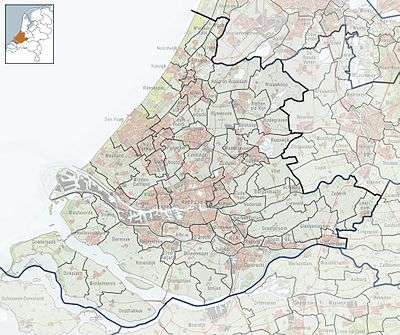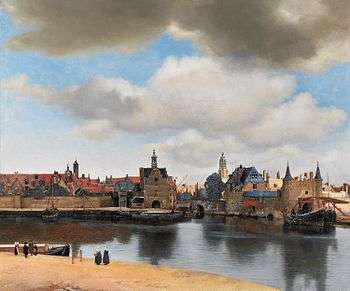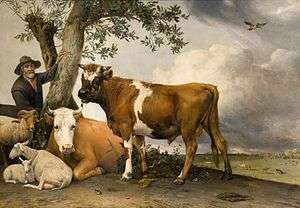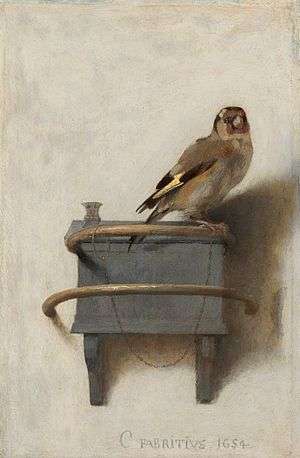Mauritshuis
 Mauritshuis in 2005 | |
 Location in South Holland in the Netherlands | |
| Established | 1822[1] |
|---|---|
| Location |
Plein 29[2] The Hague, Netherlands |
| Coordinates | 52°04′50″N 4°18′52″E / 52.080556°N 4.314444°ECoordinates: 52°04′50″N 4°18′52″E / 52.080556°N 4.314444°E |
| Type | Art museum |
| Collection size | 841 objects[3] |
| Visitors | 322,000 (2014)[4] |
| Director | Emilie E. S. Gordenker[5] |
| President | A. R. Wynaendts[5] |
| Website |
www |
The Mauritshuis (Dutch pronunciation: [ˈmʌurɪtsɦœys]; English: Maurice House) is an art museum in The Hague in the Netherlands. The museum houses the Royal Cabinet of Paintings which consists of 841 objects, mostly Dutch Golden Age paintings. The collections contains works by Johannes Vermeer, Rembrandt van Rijn, Jan Steen, Paulus Potter, Frans Hals, Jacob van Ruisdael, Hans Holbein the Younger, and others. Originally, the 17th century building was the residence of count John Maurice of Nassau. It is now the property of the government of the Netherlands and is listed in the top 100 Dutch heritage sites.
History

In 1631, John Maurice, Prince of Nassau-Siegen, a cousin of stadtholder Frederick Henry, bought a plot bordering the Binnenhof and the adjacent Hofvijver pond in The Hague,[6] at that time the political centre of the Dutch Republic. On the plot, the Mauritshuis was built between 1636 and 1641, during John Maurice's governorship of Dutch Brazil. The Dutch Classicist building was designed by the Dutch architects Jacob van Campen and Pieter Post.[7] The two-storey building is strictly symmetrical and contained four apartments and a great hall. Each apartment was designed with an antechamber, a chamber, a cabinet, and a cloakroom. Originally, the building had a cupola, which was destroyed in a fire in 1704.[8]
After the death of Prince John Maurice in 1679, the house was owned by the Maes family, who leased the house to the Dutch government. In 1704, most of the interior of the Mauritshuis was destroyed by fire. The building was restored between 1708 and 1718.[9]
In 1820, the Mauritshuis was bought by the Dutch state for the purpose of housing the Royal Cabinet of Paintings.[10] In 1822, the Mauritshuis was opened to the public and housed the Royal Cabinet of Paintings and the Royal Cabinet of Rarities. In 1875, the entire museum became available for paintings.[1]
The Mauritshuis was privatised in 1995. The foundation set up at that time took charge of both the building and the collection, which it was given on long-term loan. This building, which is the property of the state, is rented by the museum. In 2007, the museum announced its desire to expand. In 2010, the definitive design was presented.[11] The museum would occupy a part of the nearby Sociëteit de Witte building. The two buildings would be connected via an underground tunnel, running underneath the Korte Vijverberg.[12] The renovation started in 2012 and finished in 2014.[13][14] During the renovation, about 100 of the museum's paintings were displayed in the Gemeentemuseum in the Highlights Mauritshuis exhibition.[15] About 50 other paintings, including the Girl With the Pearl Earring, were on loan to exhibitions in the United States and Japan. The museum was reopened on 27 June 2014 by King Willem-Alexander.[16]
Collection
The collection of paintings of stadtholder William V, Prince of Orange was presented to the Dutch state by his son, King William I. This collection formed the basis of the Royal Cabinet of Paintings of around 200 paintings. The collection is currently called the Royal Picture Gallery. The current collection consists of almost 800 paintings[17] and focusses on Dutch and Flemish artists, such as Pieter Brueghel, Paulus Potter, Peter Paul Rubens, Rembrandt van Rijn, Jacob van Ruisdael, Johannes Vermeer, and Rogier van der Weyden. There are also works of Hans Holbein in the collection in the Mauritshuis.[18][19][20]
Selected works
%2C_Count_of_Nassau-Siegen.jpg) Prince John Maurice portrayed by Jan de Baen.
Prince John Maurice portrayed by Jan de Baen.




 Rembrandt van Rijn
Rembrandt van Rijn
Self-portrait (1669) Peter Paul Rubens
Peter Paul Rubens
Night scene (c. 1616/17) Hendrick Avercamp
Hendrick Avercamp
On the ice (c. 1610)

Administration

The Mauritshuis was state museum until 1995, when it became independent. The Prince William V Gallery is also managed by the organization.[5]
The museum has a staff of around 50 people. Emilie E. S. Gordenker has been the museum director since 2008, and Victor Moussault has been the deputy director since 2007.[5]
In the period 2005–2011, the Mauritshuis had between 205,000 and 262,000 visitors per year.[21][22][23] In 2011, the museum was the 13th most visited museum in the Netherlands.[24] In 2012, when the museum closed for renovation on 1 April, it received 45,981 visitors.[25] The museum was closed all of 2013 and was reopened on 27 June 2014.[16][26]
Visitors
| Year | Visitors | Year | Visitors | |
|---|---|---|---|---|
| 2005 | 222,477 (est.)[21] | 2010 | 231,795[22] | |
| 2006 | 244,610 (est.)[21] | 2011 | 261,127[23] | |
| 2007 | 230,000 (est.)[21] | 2012 | 45,981[25] | |
| 2008 | 240,000 (est.)[21] | 2013 | closed[26] | |
| 2009 | 205,678[22] | 2014 | 322,000 (est.)[4] |
References
- 1 2 "The Mauritshuis is turned into a museum". Mauritshuis. Archived from the original on August 23, 2006. Retrieved 2008-08-08.
- ↑ Address and directions, Mauritshuis. Retrieved on 16 June 2014.
- ↑ Search the collection, Mauritshuis. Retrieved on 16 June 2014.
- 1 2 Successful inaugural year for Mauritshuis (press release), Mauritshuis, 2014. Retrieved on 23 June 2015.
- 1 2 3 4 Who we are, Mauritshuis. Retrieved on 16 June 2014.
- ↑ "Location and garden". Mauritshuis. Archived from the original on March 6, 2007. Retrieved 2008-08-08.
- ↑ "The building". Mauritshuis. Archived from the original on June 18, 2008. Retrieved 2008-08-08.
- ↑ "The 17th-century interior". Mauritshuis. Archived from the original on July 19, 2011. Retrieved 2008-08-08.
- ↑ "Fire and restoration". Mauritshuis. Archived from the original on July 19, 2011. Retrieved 2008-08-08.
- ↑ "The Mauritshuis is turned into a museum". Mauritshuis. Archived from the original on July 19, 2011. Retrieved 2008-08-08.
- ↑ "Mauritshuis presenteert voorlopig ontwerp". Architectuur.org (in Dutch). 22 June 2010.
- ↑ "Mauritshuis aast op De Witte" (PDF). Den Haag Centraal. 3 August 2007. Archived from the original (PDF) on July 31, 2013.
- ↑ "Mauritshuis vanaf morgen voor twee jaar gesloten". Trouw (in Dutch). Retrieved 30 December 2013.
- ↑ "Mauritshuis wordt nooit een hal". De Volkskrant. 23 June 2010. Archived from the original on June 26, 2010. Retrieved 30 December 2013.
- ↑ "Highlights Mauritshuis". Gemeentemuseum. Retrieved 30 December 2013.
- 1 2 (Dutch) Nando Kasteleijn, "Het Mauritshuis is weer open. Dit moet je weten over het vernieuwde museum", NRC Handelsblad, 2014. Retrieved on 28 June 2014.
- ↑ "History of the collection". Mauritshuis. Archived from the original on June 18, 2008. Retrieved 2008-08-08.
- ↑ "Prince Willem V". Mauritshuis. Archived from the original on July 19, 2011. Retrieved 2008-08-08.
- ↑ "Royal acquisitions". Mauritshuis. Archived from the original on July 19, 2011. Retrieved 2008-08-08.
- ↑ "Acquisitions policy". Mauritshuis. Archived from the original on July 19, 2011. Retrieved 2008-08-08.
- 1 2 3 4 5 (Dutch) Top 55 Museumbezoek 2010, Museumvereniging. Retrieved on 21 June 2014.
- 1 2 3 (Dutch) Musea, erfgoed, Municipality of The Hague. Retrieved on 21 June 2014.
- 1 2 Annual Report 2011, Mauritshuis. Retrieved on 21 June 2014.
- ↑ (Dutch) Top 55 Museumbezoek 2011, Museumvereniging. Retrieved on 21 June 2014.
- 1 2 Annual Report 2012, Mauritshuis. Retrieved on 21 June 2014.
- 1 2 Mauritshuis Opening on 27 June 2014 (press release), Mauritshuis, 2013. Retrieved on 21 June 2014.
| Dutch Rijksmonument 17650 |
External links
| Wikimedia Commons has media related to Mauritshuis. |
- Mauritshuis, official website